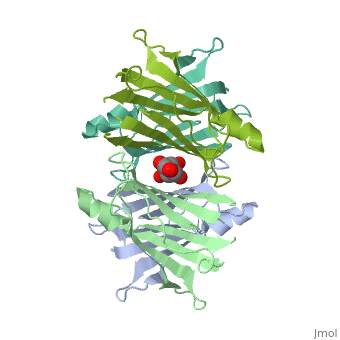Sandbox Reserved 426
From Proteopedia
| This Sandbox is Reserved from January 19, 2016, through August 31, 2016 for use for Proteopedia Team Projects by the class Chemistry 423 Biochemistry for Chemists taught by Lynmarie K Thompson at University of Massachusetts Amherst, USA. This reservation includes Sandbox Reserved 425 through Sandbox Reserved 439. |
Contents |
Human Transthyretin (TTR) complexed with genistein
Introduction
|
Encoded by Human Transthyretin gene, transthyretin (TTR) is a protein composed of identical 127-aa sandwich subunits (shown in purple). Its main function is to transport retinol and thyroxine (T4) throughout the body. Interestingly, transthyretin’s name is coming from its function: transports thyroxine and retinol. Mainly, TTR is produced by the liver, although it is also produced in smaller amounts in the choroid plexus and retinal pigment epithelium. The concentration of TTR in human plasma and cerebrospinal fluid is 0.2-0.3 mg ml-1 and 0.02 mg ml-1 respectively.
T4 is one of two major hormones produced by the thyroid gland which help control the regulation of metabolism and thus the rate at which the body uses energy. Along with two other proteins (thyroxine-binding globulin and albumin), TTR is responsible for carrying T4 in the bloodstream. In order to transport T4, four TTR proteins must bind together to form a four-protein unit (homotetramer). In addition, TTR also carries retinol (one of the major forms of vitamin A) in the blood. In this case, retinol-binding proteins (RBP) should bind to TTR (in its tetramer form).
Inappropriate folding in proteins cause a disease named amyloidosis. Amyloids (misfolded proteins) become insoluble, lose their normal function and deposit in different organs and tissues. TTR is one of the proteins that can unfold and aggregate into amyloid fibrils. TTR amyloidoses include central nervous system selective amyloidoses (CNSA), familial amyloid cardiomyopathy (FAC), familial amyloid polyneuropathy (FAP), and senile systemic amyloidosis (SSA).
Overall Structure
|
Human transthyretin (TTR) is a 55 kDa homotetramer (or more precisely, a dimer of dimers) that transports thyroxine and retinol-binding protein in the blood and cerebrospinal fluid. The monomer consists of two four-stranded β-sheets, arranged in a sandwich-like tertiary structure. The intermolecular contacts formed by the dimer–dimer interface result in the formation of a spacious channel (40 A ̊ long) running along the twofold symmetry axis of the protein. The channel is about 10 A ̊ wide at the outer rim and narrows in the centre to about 4 A ̊ . This narrowing is defined by the alignment of and on the bottom of the cleft.
Binding Interactions
|
NOT FINALIZED
Outline - Hydrogen Bonds - consist of A:LYS15(3.0) A:SER117 (3.0)/ B:LYS15(3.) B:SER117 (2.7)
Hydrophobic interaction LYS15 LEU17 - LEU110 ALA108
neighboring residues / which create the binding pocket / Residues LEU17 LYS15 - LEU110 ALA108 SER117 THR119/ The tetramer forms a central hydrophobic pocket (T4 channel) with two binding sites for the ligand.
The inner sheets of the dimer–dimer (AB–CD) interface – strands A, D, G and H – form two ligand-binding site cavities, which we will refer to as sites AC and BD, respectively
The side chains from residues Lys15 and Ser117, placed at the entrance and bottom of the binding sites, respectively, make important polar contacts with the genistein hydroxyl groups (Fig. 1). Furthermore, the apolar portion of residues Leu17, Leu110, Lys15 and Ala108 contribute to genistein binding through hydrophobic contacts, as suggested by the ligand-binding analysis
Additional Features
|
-insert possible new starting green scene
-the binding of substrate to Transthyretin requires four TTR proteins to be bound to each other simultaneously.
-four-protein unit (tetramer)
-binding and transport of thyroxine and retinol requires tetramer
-retinol requires retinol binding protein
-
Quiz Question 1
|
A. An increase in binding affinity and increase in hydrophobic interactions.
B. A decrease or even complete loss of binding affinity.
C. No change in affinity, both polar and nonpolar interactions bind retinol-binding protein and transthyretin.
Quiz Question 2
|
Genistein is a compound extracted from Soy. The binding of Genistein to TTR helps stabilize the tetramer, and thus protects it from a conformational change.
a) Why would an A108G affect the binding of Genistein? (Polar groups on TTR)
B) A V30M point mutation on Wild Type TTR has shown to change the binding mechanism of Genestein and also the overall stability of the tetramer. The V30M mutation is also linked to a change in binding affinity. What Kinetic value would you expect to change?
See Also
Credits
Introduction - name of team member
Overall Structure - name of team member
Drug Binding Site - Sonny Nguyen, Thanh Nguyen
Additional Features - Christopher Borcoche
Quiz Question 1 - name of team member
Quiz Question 2 - name of team member

